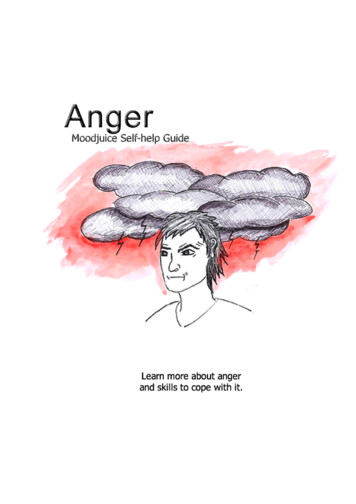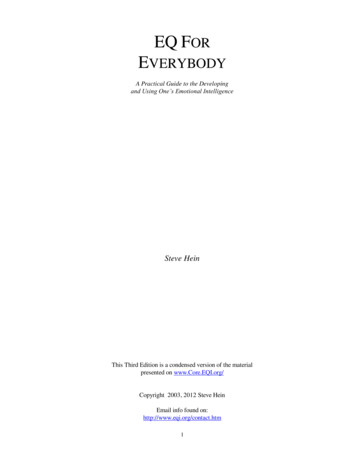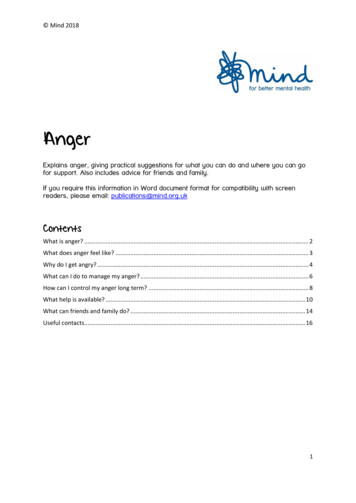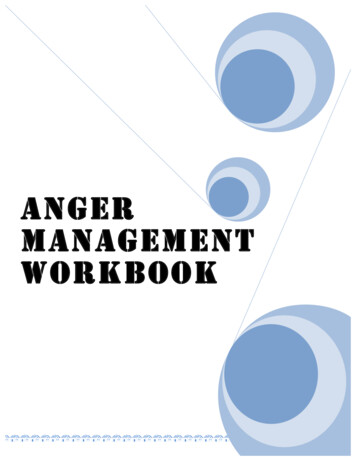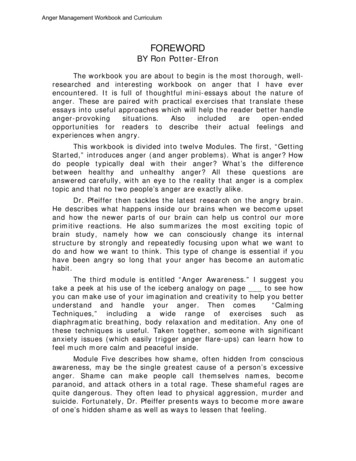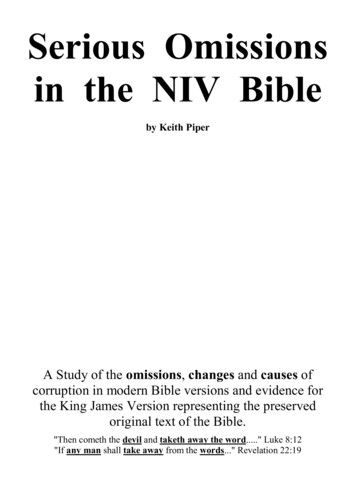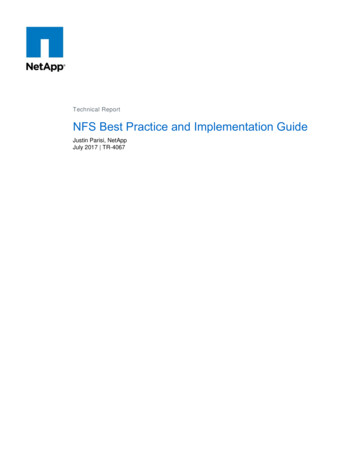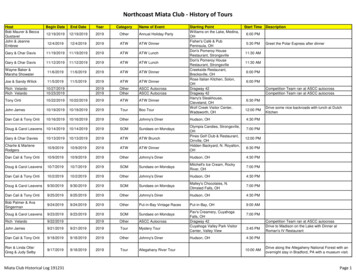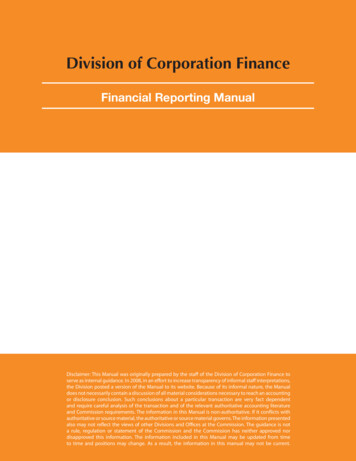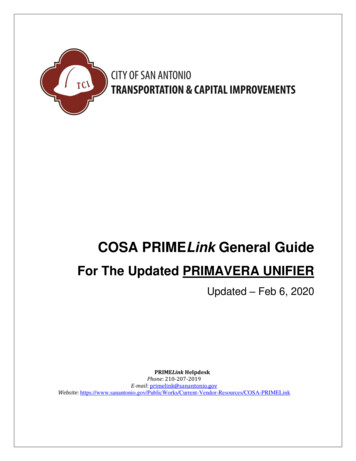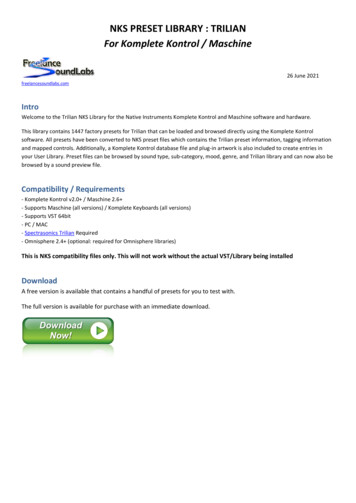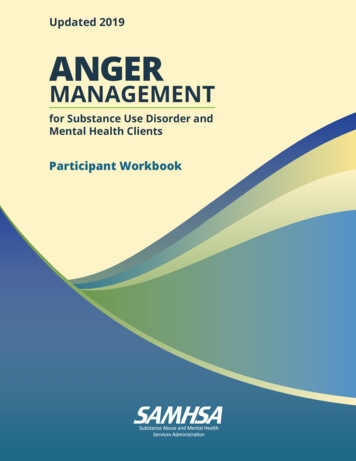
Transcription
Updated 2019ANGERMANAGEMENTfor Substance Use Disorder andMental Health ClientsParticipant Workbook
This page intentionally left blank
Anger Managementfor Substance Use Disorder and Mental Health ClientsParticipant WorkbookUPDATED 2019Patrick M. Reilly, Ph.D.Michael S. Shopshire, Ph.D.Timothy C. Durazzo, Ph.D.Torri A. Campbell, Ph.D.U.S. DEPARTMENT OF HEALTH AND HUMAN SERVICESSubstance Abuse and Mental Health Services AdministrationCenter for Substance Abuse Treatment5600 Fishers LaneRockville, MD 20857
ANGER MANAGEMENT for Substance Use Disorder and Mental Health ClientsAcknowledgmentsThis workbook was developed for use in conjunction with Anger Management for Substance Use Disorderand Mental Health Clients: A Cognitive–Behavioral Therapy Manual.This publication is, in part, a product of research conducted with support from the National Institute onDrug Abuse, Grant DA 09253, awarded to the University of California–San Francisco. The research for thispublication was also supported by funding from the Department of Veterans Affairs to the San FranciscoVeterans Affairs Medical Center. This publication was updated under contract number 270-14-0445 by theKnowledge Application Program (KAP) for the Substance Abuse and Mental Health Services Administration(SAMHSA), U.S. Department of Health and Human Services (HHS). Suzanne Wise served as the ContractingOfficer’s Representative, and Candi Byrne served as Alternate Contracting Officer’s Representative. DarrickD. Cunningham, LCSW, BCD, and Arlin Hatch, CDR, USPHS, Ph.D., served as the Product Champions.DisclaimerThe views, opinions, and content expressed herein are the views of the authors and do not necessarilyreflect the official position of SAMHSA. No official support of or endorsement by SAMHSA for theseopinions or for the instruments or resources described is intended or should be inferred. The guidelinespresented should not be considered substitutes for individualized client care and treatment decisions.Public Domain NoticeAll materials appearing in this volume except those taken directly from copyrighted sources are in the publicdomain and may be reproduced or copied without permission from SAMHSA or the authors. Citation of thesource is appreciated. However, this publication may not be reproduced or distributed for a fee without thespecific, written authorization of the Office of Communications, SAMHSA.Electronic Access and Copies of PublicationThis publication may be ordered or downloaded at https://store.samhsa.gov or by calling SAMHSA at1-877-SAMHSA-7 (1-877-726-4727) (English and Español).Recommended CitationReilly, P.M., Shopshire, M.S., Durazzo, T.C., & Campbell, T.A. Anger Management for Substance Use Disorderand Mental Health Clients: Participant Workbook. SAMHSA Publication No. PEP19-02-01-002. Rockville, MD:Substance Abuse and Mental Health Services Administration, 2019.Originating OfficeQuality Improvement and Workforce Development Branch, Division of Services Improvement, Center forSubstance Abuse Treatment, Substance Abuse and Mental Health Services Administration, 5600 FishersLane, Rockville, MD 20857, SAMHSA Publication No. PEP19-02-01-002.Nondiscrimination NoticeSAMHSA complies with applicable federal civil rights laws and does not discriminate on the basis of race,color, national origin, age, disability, or sex. SAMHSA cumple con las leyes federales de derechos civilesaplicables y no discrimina por motivos de raza, color, nacionalidad, edad, discapacidad, o sexo.SAMHSA Publication No. PEP19-02-01-002First Printed 2002Updated 2019ii
Participant WorkbookCONTENTSIntroduction . . . . . . . . . . . . . . . . . . . . . . . . . . . . . . . . . . . . . . . . . . . . . . . . . . . . . . . . . . . . . . . . . . . . 1Session 1 Overview of Anger Management Treatment . . . . . . . . . . . . . . . . . . . . . . . . . . . . . . . . . 3Session 2 Events and Cues . . . . . . . . . . . . . . . . . . . . . . . . . . . . . . . . . . . . . . . . . . . . . . . . . . . . . . . . 9Session 3 Anger Control Plans . . . . . . . . . . . . . . . . . . . . . . . . . . . . . . . . . . . . . . . . . . . . . . . . . . . . 15Session 4 The Aggression Cycle . . . . . . . . . . . . . . . . . . . . . . . . . . . . . . . . . . . . . . . . . . . . . . . . . . . 21Session 5 Cognitive Restructuring . . . . . . . . . . . . . . . . . . . . . . . . . . . . . . . . . . . . . . . . . . . . . . . . . 27Session 6 Practice Session #1 . . . . . . . . . . . . . . . . . . . . . . . . . . . . . . . . . . . . . . . . . . . . . . . . . . . . . 31Sessions 7 & 8 Assertiveness Training and the Conflict Resolution Model . . . . . . . . . . . . . . . . 35Sessions 9 & 10 Anger and the Family . . . . . . . . . . . . . . . . . . . . . . . . . . . . . . . . . . . . . . . . . . . . . 41Session 11 Practice Session #2 . . . . . . . . . . . . . . . . . . . . . . . . . . . . . . . . . . . . . . . . . . . . . . . . . . . . 47Session 12 Closing and Graduation . . . . . . . . . . . . . . . . . . . . . . . . . . . . . . . . . . . . . . . . . . . . . . . . 51Appendix Authors’ Acknowledgments . . . . . . . . . . . . . . . . . . . . . . . . . . . . . . . . . . . . . . . . . . . . . . 53iii
This page intentionally left blank
Participant WorkbookINTRODUCTIONThis workbook is designed to be used by participants in an anger management group treatmentfor individuals with substance use or mental disorders. Practitioners report that the manual andworkbook have also been used successfully for self-study, without the support of a clinician ora group. The workbook provides individuals participating in the 12-week anger managementgroup treatment with a summary of core concepts, worksheets for completing between-sessionchallenges, and space to take notes for each of the sessions. The concepts and skills presentedin the anger management treatment are best learned by practice and review and by completingthe between-session challenges in this workbook. Using this workbook as you participate in the12-week anger management group treatment will help you develop the skills that are necessaryto successfully manage anger.Introduction1
This page intentionally left blank
Participant WorkbookSession 1OVERVIEW OF ANGER MANAGEMENT TREATMENTIn this first session, you will get a general overview of the anger management treatment. Thisincludes the purpose of the group, group rules, definitions of anger and aggression, myths aboutanger, information about anger as a habitual response, and the introduction of the anger meterused to monitor anger.Purpose of the Group1. Learn to manage anger effectively.2. Stop violence or the threat of violence.3. Develop self-control over thoughts and actions.4. Receive support from others.Group Rules1. Group Safety. No violence or threats of violence toward staff or other group members arepermitted. It is very important that you view the group as a safe place to share your experiencesand feelings without threats or fear of physical harm.2. Confidentiality. Group members should not discuss outside of the group what othermembers say.3. Between-Session Challenges. Brief between-session challenges will be given each week.Completing these challenges will improve your anger management skills and allow you to get themost from the group experience.4. Absences and Cancellations. You should call or notify the group leader in advance if youcannot attend a group session. Because of the amount of material presented in each session, youmay not miss more than 3 of the 12 sessions.If you miss more than three sessions, you may continue attending the weekly sessions, but youwill not receive a certificate of completion.5. Timeouts. The group leader reserves the right to call a timeout at any time. Eventually, you willlearn to call a timeout yourself if you feel that you may be losing control because your anger isescalating.6. Relapses. If you have a relapse during enrollment in the group, you will not be discharged.However, if you have repeated relapses, you will be asked to start anger management treatmentagain and will be referred to a more intensive treatment setting.SESSION 13
ANGER MANAGEMENT for Substance Use Disorder and Mental Health ClientsDefinitionsIn the most general sense, anger is a feeling or emotion that ranges from mild irritation tointense fury and rage. Many people often confuse anger with aggression. Aggression is behaviorthat is intended to cause harm or injury to another person or damage to property. Hostility, onthe other hand, refers to a set of attitudes and judgments that motivate aggressive behaviors. Before you learned these definitions, did you ever confuse anger with aggression?Please explain how.When Does Anger Become a Problem?Anger becomes a problem when it is felt too intensely, is felt too frequently, or is expressedinappropriately. Feeling anger too intensely or frequently places extreme physical strain on the body. List some ways anger may be affecting you physically.Payoffs and ConsequencesThe inappropriate expression of anger initially has apparent payoffs (for example, releasing tension,controlling people). In the long term, however, these payoffs lead to negative consequences. Thatis why they are called “apparent” payoffs; the long-term negative consequences far outweigh theshort-term gains. List some payoffs to using anger that you are familiar with.4Overview of Group Anger Management Treatment
Participant Workbook List the negative consequences that you have experienced as a result of expressing youranger inappropriately.Myths About AngerMyth #1: The Way You Express Anger Cannot Be Changed. One misconception or myth aboutanger is that the way people express anger is inherited and cannot be changed. Our facialexpressions and our nervous system’s response when we become angry are inherited, but whatwe do next, our behavior, is learned. Because people are not born with set, specific ways ofexpressing anger, it is possible to learn more appropriate ways of expressing anger. Similarly, it isalso possible to change the way your nervous system reacts after you get angry. You can learn tocalm down more quickly with practice.Myth #2: Anger Automatically Leads to Aggression. A related myth involves the misconceptionthat the only effective way to express anger is through aggression. There are other moreconstructive and assertive ways, however, to express anger. Effective anger management involvescontrolling the escalation of anger by learning assertiveness skills, changing negative and hostilethoughts or “self-talk,” challenging irrational beliefs, and employing a variety of behavioralstrategies. These skills, techniques, and strategies will be discussed in later sessions.Myth #3: You Must Be Aggressive To Get What You Want. Many people confuse assertivenesswith aggression. The goal of aggression is to dominate, intimidate, harm, or injure anotherperson—to win at any cost. Conversely, the goal of assertiveness is to express feelings of angerin a way that is respectful of other people. Expressing yourself in an assertive manner does notblame or threaten other people and minimizes the chance of emotional harm. You will learnabout the topic of assertiveness skills in more detail in sessions 7 and 8.Myth #4: Venting Anger Is Always Desirable. For many years, there was a popular belief that theaggressive expression of anger, such as screaming or beating on pillows, was healthy and therapeutic.Research studies have found, however, that people who vent their anger aggressively simply get better atbeing angry. In other words, venting anger in an aggressive manner reinforces aggressive behavior. Before our discussion, did you believe any of these myths about anger to be true? If so, which ones?SESSION 15
ANGER MANAGEMENT for Substance Use Disorder and Mental Health ClientsAnger Is a HabitAnger can become a routine, familiar, and predictable response to a variety of situations. Whenanger is displayed frequently and aggressively, it can become a maladaptive habit. A habit, bydefinition, means performing behaviors automatically, over and over again, without thinking. Thefrequent and aggressive expression of anger can be viewed as a maladaptive habit because itresults in negative consequences. Has anger become a habit for you? How? In what ways has it been maladaptive?Breaking the Anger HabitYou can break the anger habit by becoming aware of the events and circumstances that triggeryour anger and the negative consequences that result from it. In addition, you need to develop aset of strategies to effectively manage your anger. You will learn more about strategies to manageanger in session 3. List some anger control strategies that you might know or that you may have used in the past.6Overview of Group Anger Management Treatment
Participant WorkbookAnger MeterA simple way to monitor your anger is to use a 1-to-10 scale called the anger meter. A score of1 on the anger meter represents a complete lack of anger or a total state of calm, whereas 10represents an angry and explosive loss of control that leads to negative consequences. For each day of the upcoming week, monitor and record the highest number you reach onthe anger meter.M TWThFSatSunBe prepared to report the highest level of anger you reached during the week in next week’s group.Anger Meter10 explosion violence loss of control negative consequences98765 You have a choice! Use your angercontrol plan toavoid reaching 10!4321SESSION 17
ANGER MANAGEMENT for Substance Use Disorder and Mental Health ClientsNotes8Overview of Group Anger Management Treatment
Participant WorkbookSession 2EVENTS AND CUESIn this session, you will begin to learn how to analyze an episode of anger. This involves learninghow to identify events and cues that indicate an escalation of anger.Events That Lead to AngerWhen you get angry, it is because your interpretation of an event in your life has provoked youranger. Many times, specific events touch on sensitive areas. These sensitive areas or “red flags”usually refer to longstanding issues that can easily lead to anger. In addition to events that youexperience in the here and now, you may also recall an event from your past that made youangry. Just thinking about these past events may make you angry now. Here are examples ofevents or issues that can lead to anger:— Having to wait a long time (on the phone or in an office)— Being stuck in traffic or on a crowded bus— A friend or coworker saying hurtful or untrue things— A friend not paying back money owed to you— Having to clean up someone else’s mess— Neighbors who are inconsiderate— Dealing with a frustrating person or situation on the Internet What are some of the general events and situations that lead to anger for you? What are some of the red-flag events and situations associated with anger for you?SESSION 29
Cues to Anger: Four Cue CategoriesA second important way to monitor anger is to identify the cues that occur in response to theanger-related event. These cues serve as warning signs that you have become angry and thatyour anger is escalating. Cues can be broken down into four cue categories: physical, behavioral,emotional, and cognitive (or thought) cues. After each category, list the cues that you havenoticed when you get angry.1. Physical Cues (how your body responds—with an increased heart rate, tightness in the chest,feeling hot or flushed)2. Behavioral Cues (what you do—clench your fists, raise your voice, stare at others)3. Emotional Cues (other feelings that may occur along with anger—fear, hurt, jealousy, disrespect)4. Cognitive Cues (what you think about in response to the event—hostile self-talk, images ofaggression and revenge)10 Events and Cues
Participant WorkbookCheck-In Procedure: Monitoring Anger for the WeekIn this session, you began to learn to monitor your anger and to identify anger-related eventsand situations. Monitoring your anger will help increase your awareness about your patternsof anger and identify the kinds of situations, thoughts, feelings, and consequences that areassociated with anger. In each weekly session, there will be a check-in procedure to follow up onthe between-session challenge from the previous week and to report the highest level of angerreached on the anger meter during the past week. You will also use the anger awareness recordto identify the event that led to your anger, the cues that were associated with your anger, anypositive outcomes or negative consequences, and the strategies you used to manage your angerin response to the event (see chart on page 13). You will be using the following format to check inat the beginning of each session:1. What was the highest number you reached on the anger meter during the past week?2. What was the event that led to your anger?3. What cues were associated with the anger-related event?Physical cuesBehavioral cuesEmotional cuesCognitive cues4. What strategies did you use to avoid reaching 10 on the anger meter?SESSION 2 11
For each day of the upcoming week, monitor and record the highest number you reach onthe anger meter.MTWThFSatSunEvents, Cues, and Strategies Identified During the Check-In ProcedureEvent12 Events and CuesCuesStrategies
Anger CuesWhat was I thinking?What was I feeling?What did I tell myself?SituationWhat sets me up tobecome angry?Anger Awareness Record1 Low10 HighAngerMeterRatingWhat did I do then?BehaviorWhat good or badthings happened?(positive ornegative)ConsequencesWhat tools did Iuse to respond?StrategiesUsedParticipant WorkbookSESSION 2 13
Notes14 Events and Cues
Participant WorkbookSession 3ANGER CONTROL PLANSIn this session, you will begin learning about specific strategies to manage your anger. The angercontrol plan refers to the list of strategies you will identify to manage and control your anger.Anger Control PlansUp to now, the group has been focusing on how to monitor anger. In the first session, youlearned how to use the anger meter to rate your anger. Last week, you learned how to identifythe events that lead to your anger, as well as the physical, behavioral, emotional, and cognitivecues associated with each event. You also learned to monitor the events, cues, outcomes,and strategies with the anger awareness record. In this session, you will begin to develop yourown anger control plans and learn how you can use specific strategies, such as timeouts andrelaxation, to control anger. Some people refer to their anger control plans as their toolbox andthe specific strategies they use to control their anger as the tools in their toolbox.An effective set of strategies for controlling anger should include both immediate and preventivestrategies. Examples of immediate strategies include timeouts, deep-breathing exercises, andthought stopping. Examples of preventive strategies include developing an exercise program andchanging irrational beliefs. These strategies will be discussed in later sessions.TimeoutsThe timeout is a basic anger management strategy that should be in everyone’s anger controlplan. Just as a sports team will call a timeout to regroup, you can use a timeout to collect yourselfor change the situation when you feel anger building. In its simplest form, a timeout meanstaking a few deep breaths and thinking instead of reacting. It may also mean leaving the situationthat is causing the escalation or simply stopping the discussion that is provoking your anger.You can develop a formal timeout policy that involves your relationships with family members,friends, and coworkers. The formal use of a timeout involves having an agreement, or aprearranged plan, by which any of the parties involved can call a timeout and to which all partieshave agreed in advance. The person calling the timeout can leave the situation, if necessary.It is agreed, however, that he or she will return to either finish the discussion or postpone it,depending on whether the parties involved feel they can successfully resolve the issue.A timeout is important because it can be used effectively in the heat of the moment. Even ifa person’s anger is escalating quickly as measured on the anger meter, he or she can preventreaching 10 by taking a timeout and leaving the situation.A timeout is also effective when used with other strategies. For example, you can take a timeoutand go for a walk. You can also take a timeout and call a trusted friend or family member or writein your journal. These other strategies help you calm down during your timeout period.SESSION 3 15
Social SupportAn important part of your anger control plan can be social support. We all need support atdifferent times in our lives to help us reach our goals and deal successfully with challenges thatcome our way. Having a network of people who understand and support your efforts to changecan be extremely helpful. You should seek support and feedback from family members andpeople you trust, including members of 12-Step groups, 12-Step sponsors, or other mutualhelp group members. A social support action plan that you develop yourself may help youfollow through with seeking social support.Plan for Seeking Support SupportHow This Support Will HelpPlan for Getting This SupportSupportHow This Support Will HelpPlan for Getting This SupportSupportHow This Support Will HelpPlan for Getting This SupportCan you think of someone you would reach out to for social support? How would you ask thatperson to support you?16 Anger Control Plans
Participant Workbook Can you think of situations where you would use the timeout strategy? Please describe them. Can you think of specific strategies that you might use to control your anger? Pleasedescribe them.Sample of an Anger Control Plan1. Take a timeout.2. Talk to a friend (someone you trust).3. Use the Conflict Resolution Model to solve problems with expressing anger (discussedin more detail in sessions 7 and 8).4. Exercise (for example, take a walk, go to the gym).5. Attend 12-Step meetings.6. Explore primary feelings beneath the anger.SESSION 3 17
Relaxation Through BreathingWe will end this session by practicing a deep-breathing exercise as a relaxation technique.You can practice this exercise on your own by focusing on your breathing, taking several deepbreaths, and trying to release any tension you might have in your body. You should practice thisexercise as often as possible. Here are the directions.Find a comfortable position in your chair. If you would like, close your eyes; if not, just gazedown at the floor. Take a few moments to settle yourself. Now become aware of your body.Check for any tension, beginning with your feet, moving upward to your head. Notice anytension you might have in your legs, stomach, hands and arms, shoulders, neck, and face.Try to let go of any tension.Now, become aware of your breathing. Pay attention to your breath as it enters and leavesyour body. This can be very relaxing.Take a deep breath. Notice your lungs and chest expanding. Now slowly exhale. Again, take adeep breath. Fill your lungs and your chest. Notice how much air you can take in. Hold it for asecond. Now release it and exhale slowly. Inhale slowly and fully one more time. Hold it for asecond and release.Continue breathing in this way for another couple of minutes. Continue to focus on yourbreath. With each inhalation and exhalation, feel your body becoming more and morerelaxed. Use your breathing to wash away any remaining tension.Now take another deep breath. Inhale fully, hold it for a second, and release. Inhale again,hold, and release. Continue to be aware of your breath as it fills your lungs. Once more,inhale fully, hold it for a second, and release.When you feel that you are ready, open your eyes. How was that? Did you notice any newsensations while you were breathing? How do you feel now?This breathing exercise can be shortened to just three deep inhalations and exhalations. Eventhat can be effective in helping you relax when your anger is escalating. You can practice this athome, at work, on the bus, while waiting for an appointment, or even while walking. The key tousing deep breathing as an effective relaxation technique is to practice it frequently and to applyit in a variety of situations.18 Anger Control Plans
Participant WorkbookMonitoring Anger for the Week1. What was the highest number you reached on the anger meter during the past week?Use your entries on the anger awareness record to respond to the next questions.2. What was the event that led to your anger?3. What cues were associated with the anger-related event?Physical cuesBehavioral cuesEmotional cuesCognitive cues4. What strategies did you use to avoid reaching 10 on the anger meter? For each day of the upcoming week, monitor and record the highest number you reach onthe anger meter.MTWThFSatSunSESSION 3 19
Notes20 Anger Control Plans
Participant WorkbookSession 4THE AGGRESSION CYCLEIn this session, you will learn about the aggression cycle and practice progressive musclerelaxation. The aggression cycle integrates some of the ideas and tools you’ve already learnedabout: the anger meter, cues to anger, the anger awareness record, and the anger control plan.The Aggression CycleAn episode of anger can be viewed as consisting of three phases: buildup, explosion, andaftermath. Together, these three phases make up the aggression cycle. The buildup phaseis characterized by cues that indicate anger is building. As you may recall, cues are warningsigns, or responses, to anger-related events. If the buildup phase is allowed to continue, theexplosion phase can follow. The explosion phase is marked by a discharge of anger that isdisplayed as verbal or physical aggression. The aftermath phase is characterized by the negativeconsequences that result from the verbal or physical aggression displayed during the explosionphase. These consequences may include going to jail, making restitution, being terminated froma job, being discharged from a drug treatment or social service program, losing family and lovedones, or feelings of guilt, shame, and regret.The Aggression Cycle and the Anger MeterNotice that the buildup and explosion phases of the aggression cycle correspond to levels orpoints on the anger meter. The points on the anger meter below 10 represent the buildup phase,the escalation of anger. The explosion phase, on the other hand, corresponds to a 10 on theanger meter. A 10 on the anger meter represents when you begin to lose control and expressanger through verbal or physical aggression that leads to negative consequences.One of the primary objectives of anger management treatment is to stop you from reachingthe explosion phase. This is accomplished by using the anger meter to monitor changing levelsof anger, attending to the cues or warning signs that indicate anger is building with the angerawareness record, and using the appropriate strategies from your anger control plan to stop theescalation of anger. If the explosion phase is prevented, the aftermath phase will not occur andthe aggression cycle will be broken. What phase of the aggression cycle are you in if you reach a 7 on the anger meter? What phase are you in if you reach 10 on the anger meter?SESSION 4 21
The Aggression Cycle increased heart rateflushed, hotclenched fistspacing back and forthfeelings that underlie angerhostile thoughts andself-talk fantasies, images22 The Aggression Cycle verbal aggression destructiveness violence fired from job kicked out oftreatment financial costs loss of family, friends jail guilt, shame
Participant WorkbookRelaxation Through Progressive Muscle RelaxationLast week you practiced deep breathing as a relaxation technique. This session you will learn howto use progressive muscle relaxation. You should practice this exercise as often as possible. Hereare the directions.Take a moment to settle in. Start by getting comfortable in your chair. Close your eyes if youlike. Now, as you did last week, begin to focus on your breathing. Take a deep breath. Hold itfor a second. Now exhale fully and completely. Again, take a deep breath. Fill your lungs andchest. Now release and exhale slowly. Again, one more time, inhale slowly, hold, and release.Now, while you continue to breathe deeply and fully, bring your awareness to your hands.Clench your fists tightly. Hold that tension. Now relax your fists, letting your fingers unfoldand letting your hands completely relax. Again, clench your fists tightly. Hold and release.Imagine all the tension leaving your hands down to your fingertips. Notice the differencebetween the tension and complete relaxation.Now bring your awareness to your arms. Curl your arms as if you are doing a bicep curl. Tenseyour fists, forearms, and biceps. Hold the tension and release. Let your arms unfold and yourhands float back to your thighs. Feel the tension drain out of your arms. Again, curl your armsto tighten your biceps. Notice the tension, hold, and release. Let the tension flow out of yourarms. Replace it with deep muscle relaxation.Now raise your shoulders toward your ears. Really tense your shoulders. Hold the tensionfor a second. Now gently drop your shoulders and release all the tension. Again, lift yourshoulders, hold the tension, and release. Let the tension flow from your shoulders all the waydown your arms to your fingers.Notice how different your muscles feel when they are relaxed.Now bring your awareness to your neck and your face. Tense all those muscles by making aface. Tense your neck, jaw, and forehead. Hold the tension and release. Let the muscles ofyour neck and jaw relax. Relax all the lines in your forehead. One more time, tense all themuscles in your neck and face, hold, and release. Be aware of the muscles relaxing at the topof your head and around your eyes. Let your eyes relax in their sockets, almost as if they weresinking into the back of your head. Relax your
controlling the escalation of anger by learning assertiveness skills, changing negative and hostile thoughts or “self-talk,” challenging irrational beliefs, and employing a variety of behavioral strategies. These skills, techniques, and strategies will be discussed in later sessio
